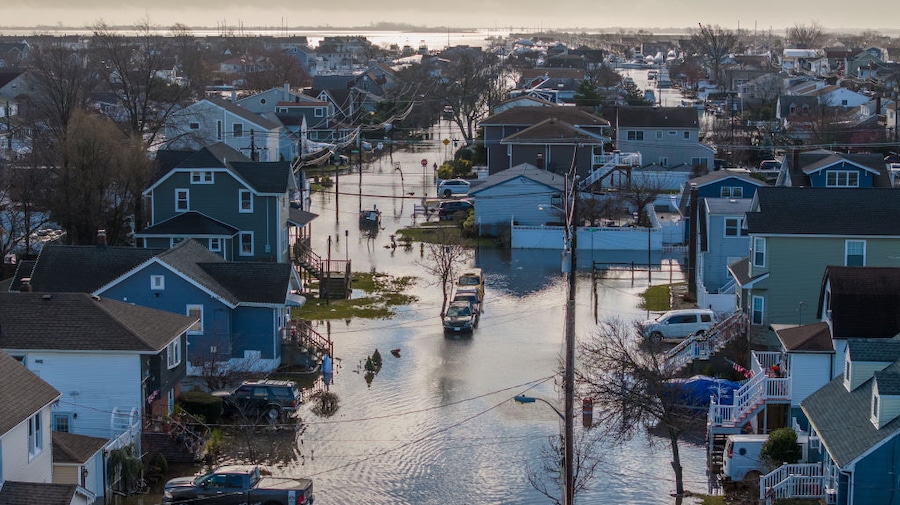This post was originally published on Eco Watch
By the year 2040, New York City and Long Island could lose over 80,000 homes to flooding, according to Averting Crisis, a new report released on Monday by the nonprofit Regional Plan Association (RPA).
The report said that in every NYC borough, it was likely that tracts of land would become impossible to develop, contributing to the area’s housing shortage, which could reach 1.2 million homes.
“Communities nationwide are facing a severe housing crisis marked by soaring costs, limited housing options, and stagnant construction. This crisis is largely driven by restrictive zoning regulations that impose onerous procedural requirements, ban multi-family housing, and create numerous technical hurdles,” the report said. “Unfortunately, climate hazards, especially flooding, will continue to exacerbate the housing shortage. The growing risk of climate-driven flooding jeopardizes both existing and future housing developed in flood zones.”
The New York City area has seen a shortage of homes over the last few decades, which has contributed to higher rents and home prices, reported The New York Times. Meanwhile, the city has been finding it hard to adapt to the increase in flooding and extreme weather due to global heating.
“The sooner we decide as a city to invest in resilience measures to help neighborhoods adapt — whether it’s to fortify or to move — the faster we avert leaving an even bigger crisis for the next generation,” said Amy Chester, managing director of nonprofit Rebuild by Design, as The New York Times reported.
In the New York, Connecticut and New Jersey tri-state area, almost one million multifamily buildings and houses have a high risk of flooding, according to the report.
By 2050, the number of at-risk affordable housing units in coastal areas is projected to triple. As greenhouse gas emissions continue to rise, extreme weather events — made worse by sea-level rise — will continue to become more frequent, severe and damaging.
“Over time, zoning has been implemented to favor sprawl while limiting compact development. As a result, our current zoning exacerbates both our housing and climate crises. The same zoning regulations that constrain compact housing development are subjecting residents to increasing and more severe climate hazards,” the report said.
In the report, RPA offered insights into zoning reform and necessary policies to address the twin climate adaptation and housing needs of the study area, which included New York City and the suburban areas of Suffolk, Nassau and Westchester Counties.
Of the 82,000 residences that could be destroyed by 2040, more than half were predicted to be on Long Island.
“Of the many climate hazards threatening the study area, flood risks may have the most impact, as approximately 77,300 acres of residential-zoned land (10.5%) could face future flooding, and by the year 2040, up to 82,000 housing units could be lost due to permanent, chronic, and coastal flooding,” the report said. “In many municipalities in Westchester and especially Long Island, locally controlled zoning often restricts residential development in locations with good transportation access, job opportunities, and limited flood exposure. Despite being close to New York City, suburbs on Long Island and in Westchester County ban multifamily development on over 95% of their residential land.”
In the city, waterfront neighborhoods in Brooklyn and Queens, such as Canarsie and the Rockaways, would experience the most flooding losses.
Some new developments in Queens’ Rockaway Peninsula — home to approximately 125,000 residents — have been trying to safeguard people against flooding while providing dense, affordable housing.
A system of engineered berms in the Rockaways with steel and stone walls at their centers will help protect the peninsula’s ocean-facing side. There hasn’t been much progress on the bay side, however, which floods on a regular basis.
Other mitigation measures in New York City that are in various stages of completion include floodgates and walls on Manhattan’s Lower East Side, as well as bluebelts connecting storm sewers to ponds and lakes.
The report said the area already needs 362,000 more homes to relieve overcrowding, provide housing for those in shelters and address low vacancy rates. An additional 895,000 units could be needed by 2040 to address flooding losses, household formation changes and dilapidation.
Towns and cities should cluster their growth in regional areas with a relatively lower flood risk that are close to commercial hubs and public transportation, according to the report.
Max Besbris, a University of Wisconsin-Madison sociology professor, said the threat of global heating means local officials need to “rethink what a conventional home looks like.”
“That means denser housing, more energy-efficient housing, and that probably means giving up on that suburban ideal of a stand-alone home with a white picket fence,” Besbris said, as reported by The New York Times.
The post NYC and Long Island Could Lose 80,000 Homes to Flooding by 2040, Exacerbating Housing Crisis: Report appeared first on EcoWatch.





0 Comments